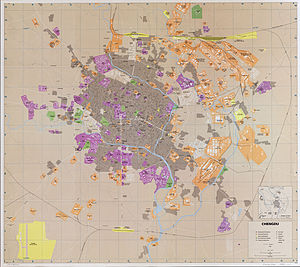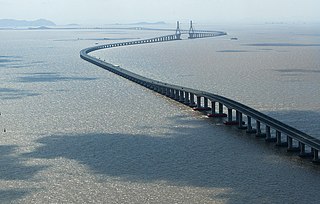
Transport in China has experienced major growth and expansion in recent years. Although China's transport system comprises a vast network of transport nodes across its huge territory, the nodes tend to concentrate in the more economically developed coastal areas and inland cities along major rivers. The physical state and comprehensiveness of China's transport infrastructure tend to vary widely by geography. While remote, rural areas still largely depend on non-mechanized means of transport, a modern maglev system was built in China to connect the city center of Shanghai with Shanghai Pudong International Airport. Airports, roads, and railway construction will provide a massive employment boost in China over the next decade.

Sichuan is a landlocked province in Southwest China occupying most of the Sichuan Basin and the easternmost part of the Tibetan Plateau between the Jinsha River on the west, the Daba Mountains in the north and the Yungui Plateau to the south. Sichuan's capital city is Chengdu. The population of Sichuan stands at 83 million. Sichuan neighbors the Qinghai to the northwest, Gansu to the north, Shaanxi to the northeast, Chongqing to the east, Guizhou to the southeast, Yunnan to the south, and the Tibet Autonomous Region to the west.

Shaanxi is a landlocked province of the People's Republic of China. Officially part of Northwest China, it borders the province-level divisions of Shanxi, Henan (E), Hubei (SE), Chongqing (S), Sichuan (SW), Gansu (W), Ningxia (NW) and Inner Mongolia (N).

Yunnan, is a landlocked province in the southwest of the People's Republic of China. The province spans approximately 394,000 km2 (152,000 sq mi) and has a population of 48.3 million. The capital of the province is Kunming. The province borders the Chinese provinces of Guizhou, Sichuan, autonomous regions of Guangxi, and Tibet as well as Southeast Asian countries: Vietnam, Laos, and Myanmar. Yunnan is China's fourth least developed province based on disposable income per capita in 2014.

Chengdu, alternatively romanized as Chengtu, is a sub-provincial city which serves as the capital of the Chinese province of Sichuan. It is traditionally the hub in Southwest China. Chengdu is considered a "Beta + " city classification according to the Globalization and World Cities Research Network. Chengdu is a leading financial centre in the Asia-Pacific region and ranks 35th globally the 2021 Global Financial Centres Index.

Chongqing, alternately romanized as Chungking, is a municipality in Southwest China. The official abbreviation of the city, "Yú", was approved by the State Council on 18 April 1997. This abbreviation is derived from the old name of a part of the Jialing River that runs through Chongqing and feeds into the Yangtze River.

Zhengzhou, also spelt Zheng Zhou and alternatively romanized as Chengchow, is the capital and largest city of Henan Province in the central part of the People's Republic of China. Located in north-central Henan, it is one of the National Central Cities in China, the centre of Central Plains area, and serves as the political, economic, technological, and educational center of the province. The Zhengzhou metropolitan area is the core area of the Central Plains Economic Zone.

Zhanjiang, historically spelled Tsamkong, is a prefecture-level city at the southwestern end of Guangdong province, People's Republic of China, facing Haikou city to the south.

The Sichuan Basin, formerly transliterated as the Szechwan Basin, sometimes called the Red Basin, is a lowland region in southwestern China. It is surrounded by mountains on all sides and is drained by the upper Yangtze River and its tributaries. The basin is anchored by Chengdu, capital of Sichuan province, in the west, and the direct-administered municipality of Chongqing in the east. Due to its relative flatness and fertile soils, it is able to support a population of more than 100 million. In addition to being a dominant geographical feature of the region, the Sichuan Basin also constitutes a cultural sphere that is distinguished by its own unique customs, cuisine and dialects. It is famous for its rice cultivation and is often considered the breadbasket of China. In the 21st century its industrial base is expanding with growth in the high-tech, aerospace, and petroleum industries.

Luzhou (simplified Chinese: 泸州; traditional Chinese: 瀘州; pinyin: Lúzhōu; Sichuanese Pinyin: Nu2zou1; Luzhou dialect: [nu˨˩tsəu˥]), formerly transliterated as Lu-chou or Luchow, is a prefecture-level city located in the southeast of Sichuan Province, China. The city, named Jiangyang until the Southern and Northern Dynasties, is known as the "Liquor City" (酒城). Situated at the confluence of the Tuo River and the Yangtze River, Luzhou is not only an important port on the Yangtze river, but also the largest port in both size and output in Sichuan province since Chongqing was separated from Sichuan province in 1997. As of the 2020 Chinese census, its population was 4,254,149 inhabitants whom 1,241,273 lived in the built-up (or metro) area made of Jiangyang and Longmatan districts, as Naxi district is not conurbated yet. Luzhou, which borders Yunnan, Guizhou and Chongqing, is the only geographic junction of the four provinces, and was therefore the logical place for a port in ancient China. After the PRC was founded in 1949, Luzhou became the capital of southern Sichuan province. In 1983, Luzhou was approved as a prefecture-level city administratively.
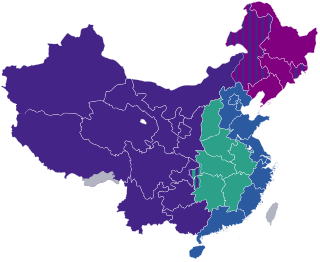
China Western Development, also Great Western Development Strategy or the Open Up the West Program, is a policy adopted for the Western China.

Guangyuan is a prefecture-level city in Sichuan Province, China, bordering the provinces of Shaanxi to the northeast and Gansu to the northwest. The city has a population of 2,305,657 as of the 2020 census.

Baoji (help·info) is a prefecture-level city in western Shaanxi province, People's Republic of China. Since the early 1990s, Baoji has been the second largest city in Shaanxi.
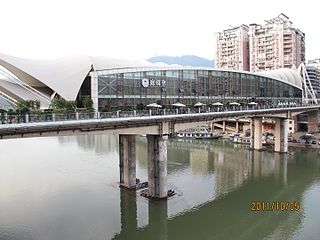
Dazhou is a prefecture-level city in the northeast corner of Sichuan province, China, bordering Shaanxi to the north and Chongqing to the east and south. As of 2020 census, Dazhou was home to 5,385,422 inhabitants whom 1,850,869 lived in the built-up area made of 2 urban districts.
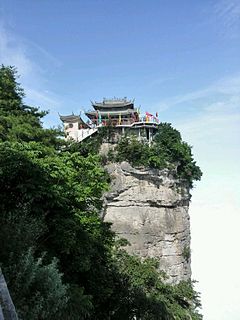
Longnan is a prefecture-level city in the southeast of Gansu province in China. It borders Sichuan on its south and Shaanxi on its east. As of the 2020 Chinese census, the population of the prefecture-level city was 2,855,555.

The Third Front Movement was a massive industrial development by China in its interior starting in 1964. It involved large-scale investment in national defense, technology, basic industries, transportation and other infrastructure investments.

Jianyang is a county-level city under the administration of the prefecture-level city of Chengdu, in Sichuan Province, Southwest China. Situated only 48 kilometers south east of the city center of Chengdu, Jianyang is administratively under the jurisdiction of Chengdu from the prefecture-level city of Ziyang since May 2016. The preparation work for changing it to "Jianyang District" is already started as of August 2019. The urban center is located on the banks of the Tuo River.

Xunyang is a county-level city in the south of Shaanxi province, China, bordering Hubei province to the northeast and southeast. It is under the administration of the prefecture-level city of Ankang. Its administrative seat is in the town of Chengguan. The county covers an area of 3,540.8 square kilometres (1,367.1 sq mi), and has a population of 450,122 as of 2019.

Xi'an–Chengdu high-speed railway or Xi'an-Chengdu Passenger Dedicated Line, is a dual-track, electrified, high-speed rail line in Western China between Xi'an and Chengdu, respectively the provincial capitals of Shaanxi and Sichuan. This line, which commenced operations on 6 December 2017, runs 510 km (320 mi) through Shaanxi and Sichuan provinces and accommodates trains traveling at speeds up to 250 km/h (160 mph). Travel time between the two provincial capitals was reduced from 16 to less than three hours.

The economy of Chongqing, China, has developed rapidly since it was separated from the Sichuan and became a centrally-administered municipality in 1997. In 2019, it was the sixth-largest Chinese city economy and ranked as China's third-largest municipal economy. In China's overall layout, Chongqing is also important for connecting China's underdeveloped western region with its more advanced eastern region, as well as promoting the economy of the mid-lower reaches of Yangtze river and the central western region.

